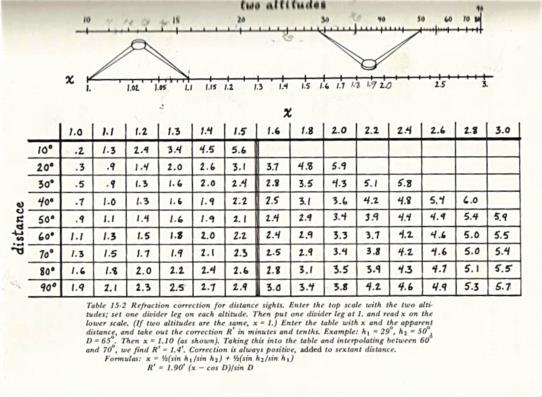
NavList:
A Community Devoted to the Preservation and Practice of Celestial Navigation and Other Methods of Traditional Wayfinding
From: Greg Rudzinski
Date: 2012 Sep 17, 12:44 -0700
Brad,
The way I understand the refraction correction as determined by table 15-2 is that the correction value is always positive and added to the observed sextant distance. If body A is at the zenith and body B is at some other elevation then the correction would be the positive value of the Nautical Almanac refraction table value for the elevation of body B. If body A and B are both on the same side of the zenith then the refraction correction value would be the difference of the two refraction values as positive values. For example if body A is at 45* elevation and body B is on the horizon then 34' - 1' = +33'( refraction value to add to the observed sextant distance to get true distance). When azimuths are between 0 and 180 degrees then the formula or table needs to be used. The special case of 0 and 180 azimuth is good for visualizing how refraction affects the distance.
Greg Rudzinski
[NavList] Re: True Distance vs. Observed Distance
From: Brad Morris
Date: 17 Sep 2012 14:54
Well, that certainly clears up my confusion when the objects are 180 degrees in azimuth.
Is this true for all azimuthal arrangements? For example, when 90 degrees apart in azimuth? Now when 0 degrees in azimuth?
Do the corner cosines ever produce a negative result? That is, when I add the corner cosine result to the observed (or subtracted from the GC distance) is the corner cosine addition result in a subtraction due to the sign of the number?
All of these questions are a function of getting it wrong the first time around. Dang! Now I get to do it all over again.
Brad Morris
On Sep 17, 2012 12:48 PM, "Greg Rudzinski" <gregrudzinski---com> wrote:
Linked is a diagram showing how refraction changes observed distance between celestial bodies. For the diagram the bodies have a distance about 45* with the zenith directly above the observer. The refraction correction is added to the observed distance to get a true distance. If starting with a true distance from a GC calculator then the refraction correction is subtracted from the true distance to get the observed distance.
Greg Rudzinski
----------------------------------------------------------------
NavList message boards and member settings: www.fer3.com/NavList
Members may optionally receive posts by email.
To cancel email delivery, send a message to NoMail[at]fer3.com
----------------------------------------------------------------







